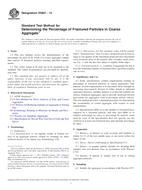Potřebujeme váš souhlas k využití jednotlivých dat, aby se vám mimo jiné mohly ukazovat informace týkající se vašich zájmů. Souhlas udělíte kliknutím na tlačítko „OK“.
ASTM D7172-14
Standard Test Method for Determining the Relative Density (Specific Gravity) and Absorption of Fine Aggregates Using Infrared (Withdrawn 2022)
Automaticky přeložený název:
Standardní zkušební metoda pro stanovení relativní hustoty (specifická hmotnost) a vstřebávání jemného kameniva pomocí infračerveného
NORMA vydána dne 1.6.2014
Informace o normě:
Označení normy: ASTM D7172-14
Poznámka: NEPLATNÁ
Datum vydání normy: 1.6.2014
Kód zboží: NS-37762
Počet stran: 5
Přibližná hmotnost: 15 g (0.03 liber)
Země: Americká technická norma
Kategorie: Technické normy ASTM
Kategorie - podobné normy:
Anotace textu normy ASTM D7172-14 :
Keywords:
absorption, aggregate, apparent density, apparent relative density, infrared, relative density, specific gravity, ICS Number Code 91.100.30 (Concrete and concrete products)
Doplňující informace
| Significance and Use | ||||||||||||||||||||||||
|
4.1 Bulk relative density (specific gravity) is the characteristic generally used for calculation of the volume occupied by the aggregate in various mixtures containing aggregate including Portland cement concrete, bituminous concrete, and other mixtures that are proportioned or analyzed on an absolute volume basis. Bulk relative density (specific gravity) is used in the computation of voids in aggregate in C1252 and C29/C29M. Bulk relative density (specific gravity) determined on the saturated surface dry (SSD) basis is used if the aggregate is wet, that is, if its absorption has been satisfied. Conversely, the bulk relative density (specific gravity) determined on the oven-dry basis is used for computations when the aggregate is dry or assumed to be dry. 4.2 Apparent relative density (specific gravity) pertains to the relative density of the solid material making up the constituent particles not including the pore space within the particles that is accessible to water. This value is not widely used in construction aggregate technology. 4.3 Water absorption values are used to calculate the change in the mass of an aggregate due to water absorbed in the pore spaces within the constituent particles, compared to the dry condition, when it is deemed that the aggregate has been in contact with water long enough to satisfy most of the absorption potential. The laboratory standard for absorption is that obtained after submerging dry aggregate for approximately 24 hours in water. Aggregates mined from below the water table may have a higher absorption when used, if not allowed to dry. Conversely, some aggregates when used may contain an amount of absorbed moisture less than the 24 hours soaked condition: For an aggregate that has been in contact with water and that had free moisture on the particle surface, the percentage of free moisture can be determined by deducting the absorption from the total moisture content determined according to C566 by drying. |
||||||||||||||||||||||||
| 1. Scope | ||||||||||||||||||||||||
|
1.1 This test method covers the determination of the relative density (specific gravity) and absorption of fine aggregates. 1.2 The values stated in SI units are to be regarded as standard. No other units of measurement are included in this standard. 1.3 This standard does not purport to address all of the safety concerns, if any, associated with its use. It is the responsibility of the user of this standard to establish appropriate safety and health practices and determine the applicability of regulatory limitations prior to use. |
||||||||||||||||||||||||
| 2. Referenced Documents | ||||||||||||||||||||||||
|
Podobné normy:
Historická
1.6.2010
Historická
1.6.2013
Historická
1.12.2013
Historická
1.7.2013
Historická
1.6.2006
Historická
1.5.2010
Doporučujeme:
Aktualizace technických norem
Chcete mít jistotu, že používáte pouze platné technické normy?
Nabízíme Vám řešení, které Vám zajistí měsíční přehled o aktuálnosti norem, které používáte.
Chcete vědět více informací? Podívejte se na tuto stránku.



 ASTM D4791-10
ASTM D4791-10 ASTM D4792/D4792M-13..
ASTM D4792/D4792M-13.. ASTM D5821-13
ASTM D5821-13 ASTM D6297-13
ASTM D6297-13 ASTM D6532-00(2006)..
ASTM D6532-00(2006).. ASTM D6884-03(2010)..
ASTM D6884-03(2010)..
 Cookies
Cookies
